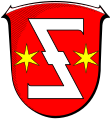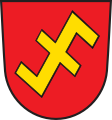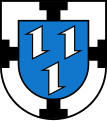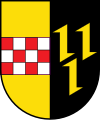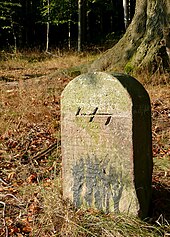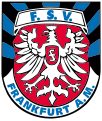Wolfsangel
The wolf fishing rod is a hunting device that was previously used to catch wolves .
General
The reproduction of an embodiment is used as a heraldic figure among other things in many family and community coats of arms, for example as a forest hook in the coat of arms of Katzweiler . Historians disagree as to whether the symbol stands for the hunting device or for a wall hook , an iron component that had to connect solid parts of the wall (such as defensive towers ). The assumption that the wolf angel is an old Germanic rune sign could not be proven, but Ihwa (ᛇ) has a similar shape.
Hunting device
The wolf rods, forged from iron, have been used to catch wolves for centuries. The barbed ends were equipped with bait (for example with the bowels of hunted animals) and hung from a tree so high that the wolf had to jump afterwards to be able to snap shut. The wolf got caught with the catch and died in long and severe agony. In 1617 the function of the wolf fishing rod was described as follows: "A Wolff's fishing rod that is hung and a carrion is put on it, if the animal jumps at it, it gets caught with its mouth."
In 1889, the art historian R. König-Warthausen described the Wolfsangel in the “Württembergische Vierteljahreshefte für Landesgeschichte” as follows: “It is a ten centimeter long flat iron, pointed on both sides, with an acute angled barb on each side, depending on the other opposite Has. The iron is pierced in the middle and hangs on a 40 centimeter long chain. At the upper part of the chain there is a crescent-shaped anchor ending in a thorn. "
The chain was attached to a tree with the crescent-shaped anchor. Parts of the fishing gear can often be found in coats of arms, according to Peter Kötz the anchor (often also referred to as "fishing rod") mainly in southern Germany, the fishing rod mainly in northern and western Germany.
Other wolf fishing rods had a spring mechanism that released when snapped shut and drove the barbs into the throat. This type of trap could also be placed on the ground. First mentions of wolf fishing are found in chapter 69 of the Capitulare de villis , a detailed regulation on the administration of the crown estates of Charlemagne , which was probably written in 812 AD; This cruel fishing method was continued until the end of the 19th century.
Finds
- During excavations of the Villa Arnesburg near Lich between 2014 and 2016, an iron wolf tang from the 8th century was recovered.
- During excavations on the Falkenburg in Detmold in 2009, over 25 wolf fishing rods came to light in a 13th century cellar.
Forms in heraldry
In heraldry there are numerous manifestations of the wolf tang. On the one hand, the actual wolf double hook, partly pointed, sometimes not, is shown, partly with a cross brace, and on the other hand the crescent-shaped anchor with a ring on the underside, which makes this the standard position. This anchor was hung in the branches, the rope with the actual wolf hook with bait at the other end ran through the ring. Usually this wolf anchor appears in groups of three on top of each other (pole-wise), with the ring facing down.
The following coats of arms are examples of the shapes:
Wolfsangel (coat of arms of Katzweiler )
Wolfsangel with cross brace (coat of arms of Idar-Oberstein )
Wolfsangel with cross brace (coat of arms of Oestrich-Winkel )
similar in Brochthausen
Wolfsangel with Palatinate Lions (coat of arms of Mannheim )
Dedinghausen , lying
Lying diagonally to the right, symbolizing the cohesion of the bourgeoisie and clergy in Halberstadt
Wolf fishing under a silver rose with a golden slug (coat of arms of Dernbach (Neuwied district) )
Wolfsangel (coat of arms of Frankfurt-Bornheim )
Coat of arms of the community of Breidenbach
Bad Westernkotten coat of arms - also called pan or salt hooks here
Wolfsangel anchor (coat of arms of Oberstadion , from the noble family )
Coat of arms of those of the Stain
Branch in the form of a wolf tang (coat of arms of Steinwedel im
Gladbeck , with wolf fishing rods from a local noble family that are also in
Bottrop and in
Hemer had possessions
In Kirchhundem the agricultural character is to be described
in 1565 awarded city coat of arms of the municipality Hollabrunn with a golden wolf tang
Uses as a symbol
Forest sign in Northern Germany
The wolf angel as a symbol has a long history in the forest sector. As early as 1616, in a border treaty between Braunschweig-Lüneburg and Hesse, the Braunschweig border marking was called "a Wulffsangel". It was not only used on boundary stones, but there is also evidence of its use in correspondence from the forestry offices from 1674.
Later the wolf tang was also used as a symbol on forest uniforms. In a bundle of files (document) from 1792, the statements of the chief forester on a new forest uniform are reproduced. Here the forester Adolf Friedrich von Stralenheim suggests that the uniform buttons be provided with the letters “GR” and a symbol. The symbol he had drawn resembled the wolf's fishing rod, but he himself labeled it as a “forest symbol”.
King Ernst August of Hanover officially made the wolf fishing a symbol of Hanover's forest and hunting service in the middle of the 19th century. A wolf tang was added to the coat of arms with a Sachsenross running on the lawn. This thus became part of various uniform parts such as buttons, epaulettes , waist belt locks and shoulder strap fittings. The wolf fishing rods were also found on the forest coupling locks of the Duchy of Braunschweig-Lüneburg, but with exactly the opposite orientation of the hooks.
Later the Wolfsangel was worn as the sole badge in brass on the service hats and on the buttons of the Hanoverian forest rangers. In Braunschweig, it was also prescribed to private forest and hunting overseers as a service badge on their headgear.
The wolf rod is still used in various forest areas in Lower Saxony as a border marker, especially at departmental boundaries. This custom seems to have existed since at least the middle of the 19th century. In 1875 , Heinrich Burckhardt wrote something about the wolf fishing in an article about the "language in the forest". Among other things, he describes the lying or standing wolf fishing sign as a scratch mark, "which he {the forester} quickly tears into the bark of the trees with the tear hook." Today the tear hook is often replaced by the paint spray can.
Wolfsangel has also survived in the hunting sector to this day. It is part of the coat of arms of the Lower Saxony State Hunters' Association and of the "Hirschmann Association", which takes care of the breeding and hunting training of Hanoverian bloodhounds .
Further symbolic use
The heath poet Hermann Löns often put the sign of the wolf fishing under his signature from 1905. For this reason, the Association of Hermann Löns Circles in Germany and Austria e. V. (short: Löns-Verband) it in its logo.
From 1991 to 2004 a similar symbol was the badge of the National Socialist Party of Ukraine (SNPU, since 2004: All-Ukrainian Association “Svoboda” ). This symbol also carries the right-wing extremist Ukrainian militia Azov , which was founded in April / May 2014 . From the perspective of Ukrainian nationalists, the Wolfsangel shows the letters “I” and “N”, which stand for “Idea of the Nation” ( Ідея Нації ).
Book cover of the novel Der Wehrwolf by Hermann Löns
Coat of arms of the 2nd SS Panzer Division "Das Reich"
Badge of the Ukrainian SNPU 1991–2004
Badge of the Ukrainian Militia Azov Regiment (until August 11, 2015)
Badge of the Ukrainian Militia Azov Regiment (since August 11, 2015)
Club crest of the SC Verl
Wolfsangel in the coat of arms of the sports club FSV Frankfurt
Prohibited use of the symbol
The Wolfsangel is sometimes used by right-wing extremists and neo-Nazis all over the world, for example as a symbol of resistance. For example, as early as the 1930s, the Alsatian autonomist young team founded by Hermann Bickler wore an armband with a wolf's tang in a brown uniform.
The Junge Front (youth organization of the People's Socialist Movement in Germany / Labor Party ), which was banned as anti-constitutional in 1982, also used the Wolfsangel as a distinguishing mark. Because of its history, the Wolfsangel is on the list of forbidden signs and, according to Section 86a of the Criminal Code, in the Federal Republic of Germany may no longer be shown as a mark of this organization or in a form that could be confused with it (publicly).
Independent uses of the wolf angel as a symbol are not affected by this ban.
literature
- Kurt Lindner : History and systematics of wolf and fox fishing (= Institutions for Allmän och Jämförande Etnografi vid Uppsala Universitet. Occasional Papers. 3, ZDB -ID 197246-7 ). Institutions för Allmän och Jämförande Etnografi vid Uppsala Universitet, Uppsala 1975.
- Gerhard Große Löscher: Sample book template and execution for hunter's blades. A comparative study on two examples with an excursus on wolf fishing. In: weapons and costume studies . Vol. 43, No. 2, 2001, Issue 2, pp. 167-188.
Web links
- Wolfsangel in the Heraldry Wiki
- Hunting with the wolf rod and the coat of arms of Fellbach. In: thomas-scharnowski.de.
- Bernhard Peter: Special motifs: The wolf tang. In: welt-der-wappen.de. Information on heraldic uses of the symbol
Individual evidence
- ↑ Bibliotheca Augustana, Karolus Magnus, Capitulare de villis. Retrieved July 21, 2010.
- ↑ Jürgen Delfs: Wolves - demonized and misunderstood. In: Jürgen Delfs u. a .: Hunting in the Lüneburg Heath. Contributions to hunting history (= publications by the Lüneburg Heath Agricultural Museum. 15). Bomann Museum u. a., Celle et al. a. 2006, ISBN 3-925902-59-7 , pp. 227-246, here pp. 238-239.
- ↑ In the footsteps of Villa Arnesburg - a medieval settlement near Lich-Muschenheim (district of Gießen). (No longer available online.) In: Website Landesamt für Denkmalpflege Hessen. Archived from the original on October 3, 2016 ; accessed on November 5, 2018 .
- ↑ AufRuhr1225: Wolf fishing at the Detmold Falkenburg found (LWL culture). on Youtube.
- ↑ Press release: Wolf fishing found for the first time in Westphalia-Lippe. In: Website Landschaftsverband Westfalen-Lippe (LWL). October 30, 2009. Retrieved November 5, 2018 .
- ↑ Gerhard Große Löscher: The wolf angel as a forest and hunting symbol in Lower Saxony. In: Jürgen Delfs: Wolves - condemned and misunderstood. In: Jürgen Delfs u. a .: Hunting in the Lüneburg Heath. Contributions to hunting history (= publications by the Lüneburg Heath Agricultural Museum. 15). Bomann Museum u. a., Celle et al. a. 2006, ISBN 3-925902-59-7 , Appendix 2.
- ↑ Ulrich Heyden: Hatred of Muscovites, Jews and “other impurities”. Telepolis, December 4, 2013, accessed December 19, 2013 .
- ↑ Azov Battalion - One troop is proud of its brown reputation. Badische Zeitung, September 30, 2014, accessed on December 8, 2014 (The AFP photo at the beginning of the article shows a militiaman with an emblem with the symbolism described here, in a slightly different color compared to the picture here).
- ↑ http://old.minjust.gov.ua/28447
- ↑ The Wolf Angel. In: netz-gegen-nazis.de. July 21, 2009, accessed May 12, 2015 .
- ↑ Philip Ch. Bankwitz: Alsatian autonomist leaders 1919–1947. The Regents Press of Kansas, Lawrence KS 1978, ISBN 0-7006-0160-0 , p. 53.
- ↑ Signs and symbols prohibited in Germany. (No longer available online.) In: Internet site information and documentation center for anti-racism work in North Rhine-Westphalia. Archived from the original on July 5, 2012 ; accessed on November 5, 2018 .
- ↑ groupings on the index. (No longer available online.) In: Internet site police crime prevention of the states and the federal government. Archived from the original on April 22, 2016 ; accessed on November 5, 2018 .
- ↑ Regional Court of Frankfurt am Main: Press release of July 5, 2004 (PDF; 249 kB) - Decision on the ban on wearing symbols of unconstitutional organizations / Bornheim coat of arms .



